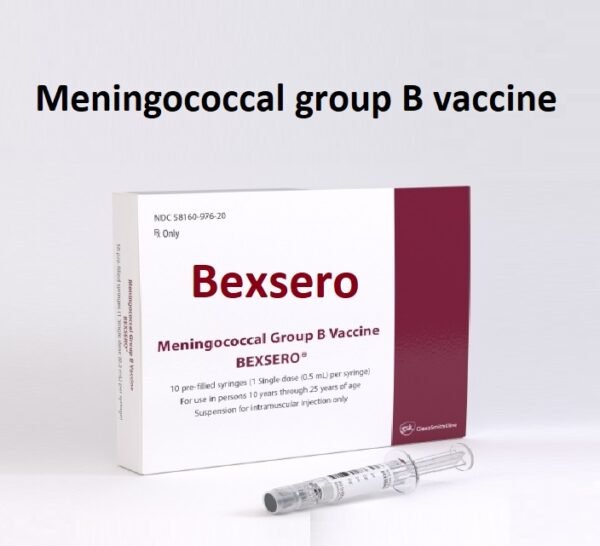Bexsero is a Meningococcal group B vaccine that is indicated for preventing Group B strain of Neiserria Meningitides in high-risk individuals.
Meningococcal group B vaccine (Bexsero) Uses:
-
Meningococcal group B disease prevention:
- US labelling: Active immunisation against invasive N. meningitidis serogroup B meningococcal disease in children, adolescents, and adults aged 10 to 25.
- The Advisory Committee on Immunization Practices (ACIP) suggests routine immunisation for the following age groups:
- Anatomically or functionally asplenia (including sickle cell disease)
- People who consistently lack one or more complement components (including patients who are taking eculizumab)
- Microbiologists are frequently exposed to Neisseria meningitidis isolates.
- Individuals recognised as being more vulnerable as a result of an epidemic of serogroup B meningococcal illness
-
The ACIP advises adolescents and young adults between the ages of 16 and 23 to undertake a meningococcal group B vaccine series to provide short-term protection against the majority of serogroup B meningococcal illness strains. Between the ages of 16 and 18 is when vaccinations are most effective.
-
Canadian labels: Bexsero is advised for usage in kids, teenagers, and adults up to the age of 25.
-
The National Advisory Committee on Immunization (NACI) of Canada advises avoiding it when given to healthy individuals between the ages of 2 months and 24 years who are at high risk for serogroup B meningococcal illness (including disease outbreaks). A person's unique circumstances might be taken into consideration.
Meningococcal group B vaccine (Bexsero) Dose in Adults:
Meningococcal group B vaccine (Bexsero) Dose in the prevention of Meningococcal group B disease:
-
ACIP recommendations:
Note:
-
The ACIP recommends routine vaccines only for people above the age of 10 who have a higher risk of serogroup B meningococcal illness. Over 25s are eligible to receive vaccinations.
-
When deciding on a timetable, take into account the danger of exposure and the patient's tendency for the sickness.
- Patients who are more likely to get serogroup B meningococcal disease or who are exposed to the disease during an outbreak:
- Bexsero:
- IM: 2 doses of 0.5 mL each, spaced about a month apart.
- Trumenba:
- The third dose is not necessary if there is a 6-month gap in the middle of the first and second doses.
- IM: Three doses of 0.5 mL each are administered at 0, 1–2 months, and 6 months.
- Patients not at increased risk for meningococcal illness and are between the ages of 16 and 23 (preferable: 16 and 18):
- Note: To offer momentary defense against the majority of serogroup B meningococcal illness strains:
- Bexsero:
- IM: 2 doses of 0.5 mL each, spaced about a month apart.
- Trumenba:
- IM: 2 doses of 0.5 mL each, spaced six months apart.
- The third dose should be given four months after the second dose if it is given earlier than six months.
- Bexsero:
-
NACI recommendations (NACI/CATMAT 2015):
Note:
- The Trumenba product is not covered by the current regulations.
- The vaccine is approved for use in adults above the age of 25, although NACI suggests that any adult who is at a high chance of serogroup B meningococcal illness must be vaccinated.
- Consider the risk of exposure and the patient's propensity for the illness while choosing a schedule.
- Bexsero:
- The third dose should be given four months after the second if the second dose was given earlier than six months..
- IM: two doses of 0.5 mL each, spaced approximately four weeks apart.
Meningococcal group B vaccine (Bexsero) Dose in the Close contacts and outbreak control of meningococcal serogroup B disease:
-
Unvaccinated:
- IM: 0.5 mL shortly following exposure; revaccinate in one dosage four weeks after the initial dose
-
Previously vaccinated:
- IM: 0.5 mL right after exposure
-
Trumenba (Canadian labeling):
- Regular schedule:
- IM: Two doses of 0.5 mL each are administered over the course of 0 and 6 months.
- Patients at high risk for meningococcal serogroup B disease:
- IM: Three doses of 0.5 mL each are delivered; doses 1 and 2 are spaced by approximately one month, and dose 3 is given approximately four months following dosage 2.
- Regular schedule:
Meningococcal group B vaccine (Bexsero) Dose in Children:
Meningococcal group B vaccine (Bexsero) Dose in preventing Meningococcal group B disease:
Key point:
- The same product should be used for each dose in the series since products (Bexsero/Trumenba) cannot be substituted for one another.
ACIP Suggestions:
- While 10 to 15-year-old patients who are not at risk for infection should not use the medication, it is FDA-approved for use in children and adolescents under 10 years of age.
Use in patients under the age of 16 who are not at risk is determined by clinical judgment.
If any of the following high-risk scenarios apply to children and adolescents younger than 10 years old, the ACIP advises regular vaccination:- Deficits in the complement component that have persisted (inherited or chronic).
- Patients with either anatomical or functional asplenia who are receiving eculizumab.
- People who have been recognized as having a higher risk of developing a serogroup B meningococcal illness during an outbreak.
-
Patients at advanced risk:
-
Children older than 10 years and Adolescents:
-
Note:
- Consider the patient's predisposition for the disease and the risk of exposure when choosing a schedule; for more information, refer to the ACIP guidelines.
- Bexsero:
- IM: 0.5 mL each dose, divided into two doses at least one month apart.
- Trumenba:
- 2-dose schedule:
- IM: Two dosages of 0.5 mL each are delivered as follows: first dose, then a second dose six months later.
- Note: If it has been less than 6 months since the first and second doses, give the third dose four months after the second dose (manufacturer labeling).
- 3-dose schedule:
- IM: 3 dosages of 0.5 mL each are delivered as follows:
- Following the initial dose, there will be a second and third dose given 1 to 2 months and 6 months later, respectively.
- The third dose is not necessary if it has been more than six months after the first and second doses.
- 2-dose schedule:
- Bexsero:
-
Patients not at increased risk (per clinical discretion):
To offer momentary defense against the majority of serogroup B meningococcal illness strains:
-
-
Adolescents ≥16 years:
- IM: It takes 0.5 mL per dose. Give either Trumenba or Bexsero in a 2dose course, separated by a month (separate doses by 6 months; if the second dose is administered earlier than 6 months, a third dose should be given 4 months after the second dose)
-
NACI suggestions and Canadian labeling:
- Bexsero:
-
Patients who are at high risk for serogroup B meningococcal disease or healthy people who are not at high risk for meningitis (at the discretion of the doctor):
- When selecting a schedule, take into account the danger of exposure and the patient's propensity for the illness.
-
- Infants 2 to 5 months:
- Alternatively, the first three doses may be administered at 2, 3, and 4 months of age; however, this regimen results in a lower immunological response to one of the vaccine's components (NHBA).
- IM: There are a total of 4 doses (0.5 mL each), given between the ages of 2 and 6 months for the first baby series and 12 and 23 months for the booster dose.
- Infants 6 months to <12 months (unvaccinated):
- IM: The first two doses must be administered at least two months apart, and there are a total of three doses (0.5 mL each). During the second year of life, at least two months after the second dosage, the third dose is administered. The need for a booster dosage has not yet been identified.
- Children aged between one and two years (unvaccinated):
- IM: Two doses totaling 0.5 mL each, given at least two months apart.
- It has not been determined whether a booster dose is necessary.
- Children between the ages of 2 and 11:
- IM: Two doses total, separated by at least two months. It is uncertain if a higher dosage is required.
- IM: Two doses totaling 0.5 mL each, given at least one month apart.
- It is unknown whether additional doses are required. Meningococcal serogroup B illness close contacts and outbreak control (NACI/CATMAT 2015):
- When selecting a schedule, take into account the danger of exposure and the patient's propensity for the illness.
Infants 2 months to <6 months:
- Without vaccination:
- Revaccinate with two further doses, separated by around four weeks.
- IM: 0.5 mL right away following exposure.
- Previously vaccinated:
- IM: 0.5 mL right away following exposure.
- Infants 6 months to Children <11 years:
- Previously vaccinated:
- IM: 0.5 mL directly after exposure
- Without vaccination:
- IM: 0.5 mL directly upon exposure; revaccinate in one dosage eight weeks after the first dose
- Previously vaccinated:
- Children ≥11 years and Adolescents:
- Previously vaccinated:
- IM: 0.5 mL directly after exposure
- Unvaccinated:
- IM: 0.5 mL as soon as the exposure takes place; revaccinate once about 4 weeks following the first dose.
- Previously vaccinated:
- Trumenba:
- Children ≥10 years and Adolescents:
- Regular schedule:
- IM: Two doses of 0.5 mL each, spaced by six months, are given as a series over two doses (eg, a 0- and 6-month schedule)
- Patients at higher risk for serogroup B meningococcal disease:
- IM: Three doses of 0.5 mL each are delivered; doses 1 and 2 are spaced by approximately one month, and dose 3 is given approximately four months following dosage 2.
- Regular schedule:
- Children ≥10 years and Adolescents:
Note: The Trumenba product is not covered by the most recent regulations (NACI/CATMAT 2015).
Meningococcal group B vaccine (Bexsero) Pregnancy Risk Category: B
- The fetus is not put in higher danger by inactivated vaccinations.
- According to the Advisory Committee on Immunization Practices, pregnant women shouldn't have meningococcal group A vaccinations unless they have a higher risk of developing meningococcal illnesses or the advantages of the vaccine outweigh the risks.
Use of the meningococcal group A vaccine during breastfeeding
- It is not known if breastmilk contains vaccines.
- Think about the dangers of exposing newborns, the advantages of breastfeeding, and the advantages of vaccination for the mother following vaccination.
- The Advisory Committee on Immunization Practices advises breastfeeding women to get the meningococcal group A vaccine unless they are at a higher risk of contracting the disease.
Dose in Kidney Disease:
No dosage modification was provided by the manufacturer
Dose in Liver disease:
No dosage modification was provided by the manufacturer
Common Side Effects of Meningococcal group B vaccine (Bexsero):
-
Neuromuscular & Skeletal:
- Arthralgia
- Myalgia
-
Central Nervous System:
- Malaise
- Irritability
- Drowsiness
- Fatigue
- Headache
- Excessive Crying
- Chills
-
Local:
- Tenderness At Injection Site
- Swelling At Injection Site
- Pain At Injection Site
- Erythema At Injection Site
- Induration At Injection Site
-
Gastrointestinal:
- Nausea
- Change In Appetite
- Diarrhea
- Vomiting
-
Miscellaneous:
- Fever
Less Common Side Effects Of Meningococcal group B vaccine (Bexsero):
-
Dermatologic:
- Skin Rash
- Urticaria
-
Respiratory:
- Upper Respiratory Tract Infection
- Nasopharyngitis
Contraindications to Meningococcal group B vaccine (Bexsero):
Hypersensitivity to the group B meningococcal vaccine or any of the formulation's ingredients
Labeling in Canada: Additional precautions not mentioned on the labeling in the US
- Trumenba: Extreme allergy reactions (eg anaphylaxis), following a previous dose
Warnings and precautions
-
Anaphylactoid reactions and hypersensitivity reactions
- During vaccination, immediate treatment should be available for hypersensitivity reactions and anaphylactoid reactions (epinephrine 1mg/mL).
-
Apnea
- Premature infants may experience apnea after immunization, particularly if they have had a history of respiratory illness.
-
Syncope
- Injectable immunizations have the potential to cause syncope. There's a chance you could have really bad secondary injuries (eg skull fracture, cerebral hemorrhage).
- Usually, this happens in young people within 15 minutes of administration.
- In the event of syncope, it's crucial to have measures in place to restore cerebral perfusion and prevent damage from falling.
-
Acute illness:
- The degree of the symptoms and the cause will determine whether or not immunization is necessary.
- Patients with severe or moderate acute illness should be given vaccines as soon as possible.
- Patients with modest acute illnesses shouldn't postpone their administration, fever or not.
-
Bleeding disorders:
- Patients with thrombocytopenia and other bleeding disorders need to exercise caution. Hemorrhage or bleeding from injections is possible.
- Those who have thrombocytopenia or other bleeding disorders should exercise caution. Injections might result in bleeding or hematoma.
-
Meningococcal Infections:
- All meningococcal group-B strains that are currently in circulation cannot be prevented by vaccination.
- It is not advised to be used to prevent N. meningitides serogroups C, W-135, and Y infection or to treat a meningococcal infection.
Meningococcal group B vaccine (MenB-4C and MenBFHbp): Drug Interaction
|
Risk Factor C (Monitor therapy) |
|
|
Venetoclax |
May reduce a vaccine's therapeutic effect (Inactivated). |
|
Risk Factor D (Consider therapy modification) |
|
|
Eculizumab |
May reduce the meningococcal group b vaccine's therapeutic efficacy. Meningococcal Group B Vaccine may lessen Eculizumab's therapeutic efficacy. Increased complement activation brought on by the meningococcal vaccine may make any preexisting complement-mediated illnesses, like hemolysis and anemia, worse. |
|
Fingolimod |
May reduce a vaccine's therapeutic effect (Inactivated). Management: Vaccine effectiveness could be affected. Before beginning fingolimod, all age-appropriate vaccines must be finished at least two weeks in advance. If vaccinated while on fingolimod therapy, vaccinate again 2 to 3 months after stopping fingolimod. |
|
Immunosuppressants |
May reduce a vaccine's therapeutic effect (Inactivated). Management: Vaccine effectiveness could be affected. Before beginning an immunosuppressant, finish all age-appropriate vaccines at least two weeks in advance. If vaccinated while taking immunosuppressant medication, revaccinate at least three months after stopping the medication. Cytarabine is an exception (Liposomal). |
|
Siponimod |
May reduce a vaccine's therapeutic effect (Inactivated). Management: Due to the possibility of diminished vaccine efficacy, avoid administering inactivated vaccines for 1 month after stopping siponimod medication. |
Monitoring parameters:
- Respiratory function in premature newborns for 48 to 72 hours after vaccination (especially if born before 28 weeks of gestation or if there is a history of respiratory immaturity).
- After injection, wait 15 minutes before checking for syncope.
- Maintain the patient in a supine or Trendelenburg position if seizure-like activity accompanied by syncope occurs in order to restore appropriate cerebral perfusion.
How to administer Meningococcal group B vaccine (Bexsero)?
- IM:
- Only IM administration; ideally into the upper deltoid area.
- Don't use the IV, SubQ, or intradermal routes of administration.
- Use different needles for each injection; do not combine them with other injections or immunizations.
- Keep the patient in a lying position to avoid syncope-related adverse effects.
- When giving IM to patients who are at an elevated risk of bleeding, use clinical judgment.
- The immunization should be scheduled soon after the patient obtains antihemophilic or another related therapy if they do.
- Don't massage the injection site; instead, use a tiny needle.
- Educate the patient regarding the possibility of hematoma formation.
- Treat patients on anticoagulation the same as those with clotting factor abnormalities.
Mechanism of action of Meningococcal group B vaccine (Bexsero):
Bexsero
- Immunity to serogroup-specific meningococcal illnesses The development of antibodies against the outer membrane vesicles and recombinant protein antigens of a group-B strain results in Neisseria meningitides.
Trumenba:
- Complement-mediated antibody-dependent death is a defense against invasive meningococcal infections. It is dependent on N. meningitidis.
Efficacy:
- Trumenba:
- After receiving their third dose, 84% of teenagers saw their hSBA titer and composite response increase by more than four times.
- Bexsero
- Composite hSBA Titer Response one Month After the Second Dose: 63% to 88%
International Brand Names of Meningococcal group B vaccine:
- Bexsero
- Trumenba
Meningococcal group B vaccine Brand Names in Pakistan:
No Brands Available in Pakistan.



 Injection.webp)
.webp)